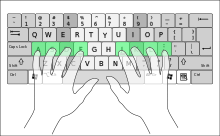Resting position

A resting position or rest position is a default human position or pose assumed (typically deliberately) when a person is not engaged in an activity that demands some other pose, or between poses.
General rest positions[edit]
Common resting positions of the body include kneeling, leaning, lying, sitting, and squatting. In microgravity, the relaxed human body naturally assumes neutral body posture.[1]
Rest positions in specific activities[edit]



A number of disciplines specify particular resting positions, with various purposes.
Body[edit]
Ballet incorporates several resting poses, including a neutral pose described by Cesare Negri and Jacob de Gheyn II with the feet at 45 degrees, back strait, and chin erect.[2] Neoclassical ballet includes a rest or "preparatory" position called "B plus" (possibly named for George Balanchine), also called attitude a terre, in which the standing leg is straight, and the back leg curved with the toe pointed.[3]
Military parade discipline includes standing rest positions, generally assumed following a command of "At ease", "Stand easy", or "Relax".[4][5]
Some forms of yoga incorporate the Shavasana or "Corpse Pose", a rest position used for wakeful relaxation and meditation, often at the end of a session.[6]
Hands and arms[edit]
Gun safety rules generally specify that the trigger finger should not rest on the trigger when not firing, but alongside the trigger guard.[7]
In various sign languages, rest positions may be used to convey grammatical meaning.[8]
In touch typing, the home row is a rest position for the hands, placing all the standard keys within easy reach.[9]
References[edit]
- ^ "NASA Standards Inform Comfortable Car Seats". NASA. Retrieved 28 May 2015.
- ^ Gilman, Sander L. (February 15, 2018). Stand Up Straight!: A History of Posture. Chapter 5: Dance and the Social Taming of Posture: Reaktion Books. ISBN 9781780239644. Retrieved 18 September 2019.
{{cite book}}: CS1 maint: location (link) - ^ Minden, Gaynor (21 October 2013). "Terms & Positions". Dancer.com. Retrieved 18 September 2019.
- ^ Powers, Rod (September 17, 2018). "Individual Drill Commands: How to Execute Drill Commands". Retrieved 18 September 2019.
- ^ "Understanding Stationary Drill". Military.com. Retrieved 18 September 2019.
- ^ "The History Behind Savasana". Boston Yoga. 6 October 2012. Retrieved 7 March 2017.
- ^ Ayoob, Massad (January–February 2007). "The subtleties of safe firearms handling". Backwoods Home Magazine. Retrieved December 22, 2015.
- ^ Lackner, Andrea (June 28, 2017). "Sign language has grammar—and it goes way beyond what you do with your hands". Quartz. Retrieved 9 September 2019.
- ^ "Home row". Dictionary,com. Retrieved 11 September 2019.
